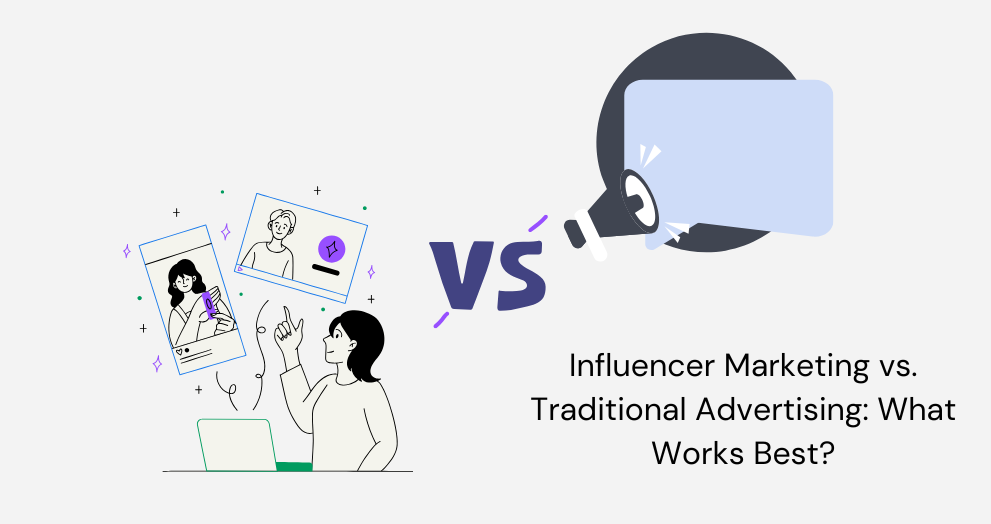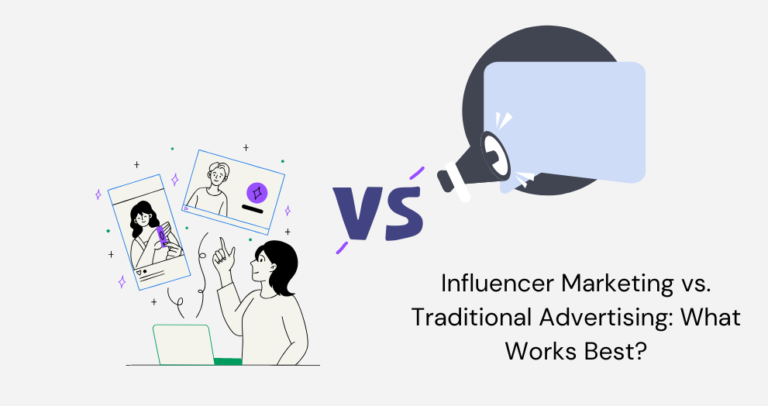
Influencer Marketing vs. Traditional Advertising: What Works Best?
Marketing has developed outstandingly, adapting to new technologies, consumer behaviors, and cultural shifts. Traditional advertising, once the dominant force in reaching audiences, has faced increasing competition from influencer marketing, a strategy that leverages individuals with a strong online presence to promote products and services. But which approach is more effective?
Traditional Advertising
What is Traditional Advertising?
Traditional advertising refers to promotional strategies that use established media channels such as:
- Television commercials
- Radio advertisements
- Newspaper and magazine ads
- Billboards and outdoor advertising
- Direct mail (flyers, brochures, catalogs, etc.)
These forms of advertising have been used for decades to reach large audiences and build brand awareness.
Advantages of Traditional Advertising
✅ Wider Audience Reach – TV, radio, and print media can reach millions of people at once.
✅ Credibility & Trust – Consumers often trust brands they see in well-established media outlets.
✅ Local and Global Impact – Traditional ads can be tailored to local and global audiences.
Disadvantages of Traditional Advertising
❌ High Costs – TV commercials and billboards require significant financial investment.
❌ Limited Targeting – Unlike digital marketing, traditional ads are less precise in reaching specific demographics.
❌ One-Way Communication – Consumers cannot interact with traditional ads, limiting engagement.
Influencer Marketing
What is Influencer Marketing?
Influencer marketing involves brands partnering with social media influencers, bloggers, YouTubers, and content creators to promote products and services. Influencers engage audiences on platforms like:
- YouTube
- TikTok
- Twitter/X
Types of Influencers
🔹 Mega Influencers (1M+ followers) – Celebrities and public figures with massive reach. 🔹 Macro Influencers (100K – 1M followers) – Industry experts and popular content creators. 🔹 Micro Influencers (10K – 100K followers) – Niche influencers with high engagement rates. 🔹 Nano Influencers (1K – 10K followers) – Small but highly trusted voices in niche communities.
Advantages of Influencer Marketing
✅ Authenticity & Trust – Audiences trust influencers’ recommendations, seeing them as personal endorsements.
✅ Targeted Audience – Influencers cater to specific demographics, making marketing efforts more precise.
✅ Cost-Effective – Compared to traditional ads, influencer campaigns can be more affordable.
✅ Higher Engagement – Social media platforms allow real-time interactions and discussions about products.
Disadvantages of Influencer Marketing
❌ Risk of Fake Followers – Some influencers may inflate their numbers, reducing campaign effectiveness.
❌ Limited Control – Brands have less control over how influencers present their products.
❌ Short-Term Visibility – Unlike traditional ads, social media content may have a shorter lifespan.
Which One Works Best?
1. Audience Reach
- Traditional Advertising wins when it comes to mass audience exposure (TV, billboards, print ads).
- Influencer Marketing excels at targeting specific audiences who are already engaged.
2. Engagement & Interaction
- Traditional Ads offer a passive experience with limited interaction.
- Influencer Marketing encourages active engagement, comments, and shares.
3. Cost Efficiency
- Traditional Advertising is expensive and requires a significant budget.
- Influencer Marketing can be more affordable and flexible, with options for all budget levels.
4. Credibility & Trust
- Traditional Ads rely on brand reputation but may feel impersonal.
- Influencer Marketing builds trust through personal recommendations and relatability.
5. Longevity & Impact
- Traditional Ads (TV, print) can have long-term brand recognition.
- Influencer Content is more short-lived but generates immediate buzz and social proof.
Conclusion: The Best Approach?
There is no one-size-fits-all answer. The best approach depends on:
- Your business goals (brand awareness vs. direct engagement)
- Target audience (mass-market vs. niche-specific)
- Budget (big ad spend vs. cost-effective strategies)
- Industry trends (some industries benefit more from influencers, like fashion, beauty, and tech)
Many successful brands combine both strategies—using traditional ads for brand recognition and influencer marketing for audience engagement. A hybrid approach allows businesses to leverage the strengths of both methods for maximum impact.
Key Takeaways
✅ Traditional Advertising is great for mass exposure but is costly and less interactive.
✅ Influencer Marketing is more engaging, cost-effective, and trusted but may have limited control.
✅ Combining both approaches can provide a well-rounded marketing strategy.





